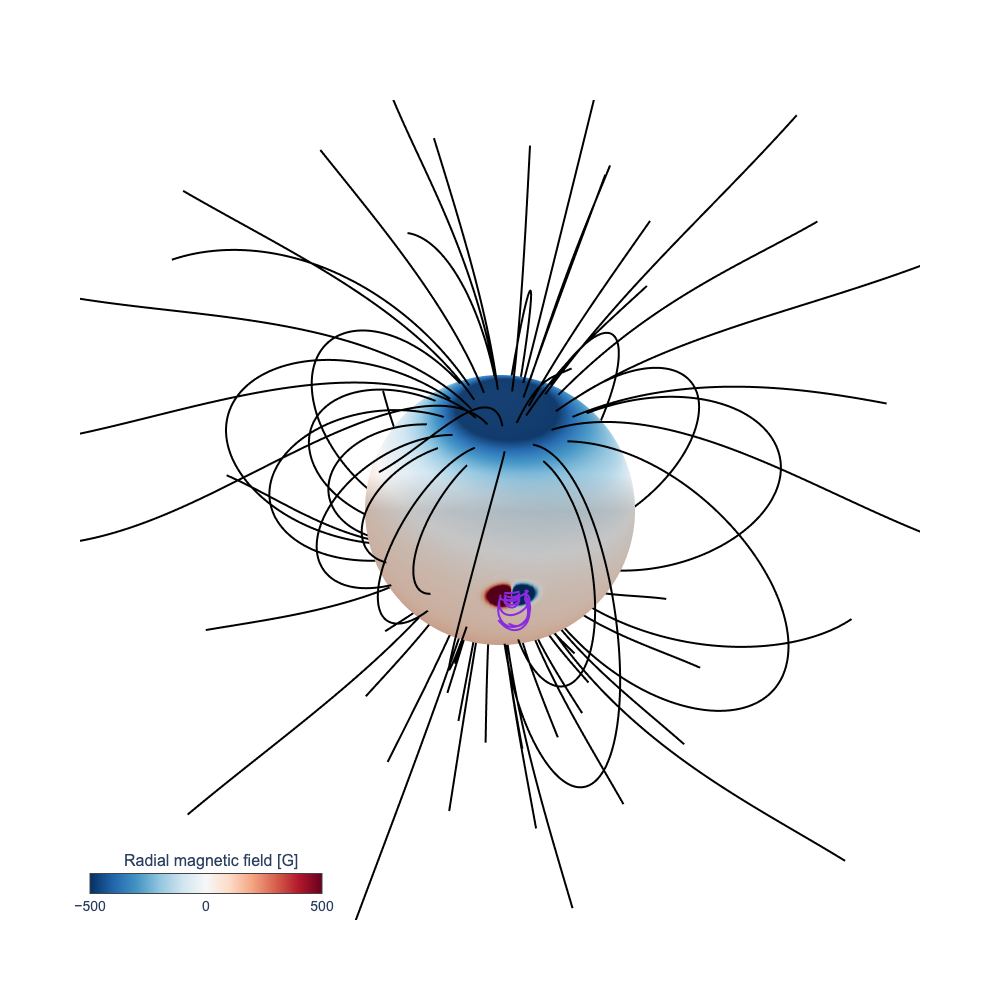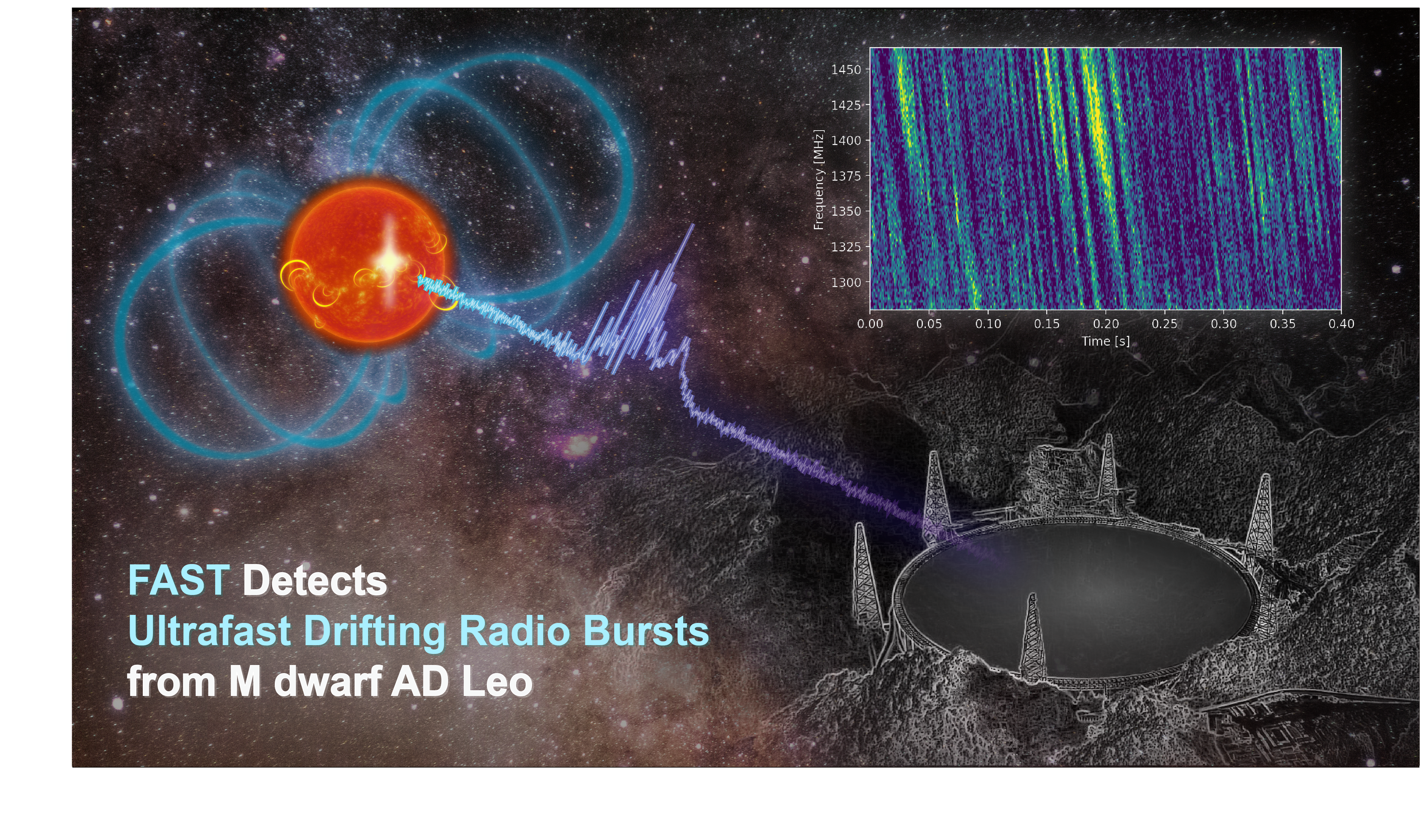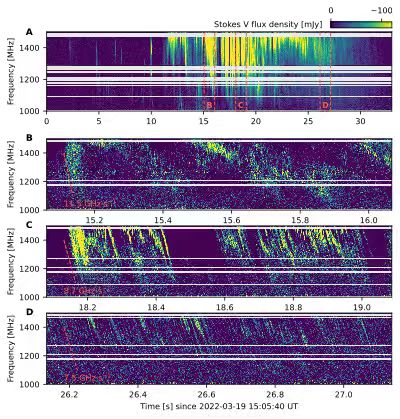Peking University, October 22, 2025: A research team led by Prof.
Tian Hui and his Ph.D. student
Zhang Jiale from the School of Earth and Space Sciences, Peking University, has made significant progress in studying stellar magnetic activity. Using observations taken from the Five-hundred-meter Aperture Spherical Radio Telescope (FAST), known as the “China Sky Eye”, the team uncovered a new type of millisecond-scale radio bursts from an M-type star AD Leo. By combining these observations with surface magnetic field measurements, they confirmed that the radio signals originate from small-scale magnetic structures in the starspot regions. This work fills a long-standing gap in our understanding of small-scale magnetic fields on stars beyond the solar system and provides new insights into the mechanisms behind their coronal eruptions and space weather phenomena. The result was recently published in
Science Advances.
Fig. 1 Dynamic spectrum(A)and fine structures(B, C, D)of radio emission from AD Leo
The magnetic field of the Sun drives solar activity such as flares and coronal mass ejections, which can disturb the space environment of the solar system and affect satellites, communications, navigation, and power systems on Earth. These activities can be traced to active regions above sunspots, where the magnetic field is strongest on the surface. Similar magnetic activity is observed on other late-type stars, particularly active M dwarfs, where such events are often more intense and frequent. They can potentially strip the planetary atmospheres and impact the habitability of nearby exoplanets.
Measuring small-scale magnetic fields on other stars beyond our sun is essential for understanding the origin of stellar magnetic activity and its potential impacts on exoplanets. Traditional techniques, such as Zeeman Doppler Imaging, can only probe global, large-scale magnetic structures and cannot resolve the small-scale fields in starspot regions. Radio observations offer an alternative approach to measuring the field strength. However, as the stellar surface remains unresolved, it has been challenging to determine whether the detected radio emission arises from large-scale or small-scale magnetic structures.

Fig. 2 3D magnetic field model of AD Leo. The surface radial magnetic field strength is shown in the center. The black magnetic field lines represent the global large-scale magnetic field, while the purple lines illustrate the small-scale magnetic fields in the starspot region (the source of the radio emission).
Using observations from FAST,
Tian Hui and
Zhang Jiale discovered that stellar radio emissions often exhibit millisecond-scale fine structures, which encode key information about the magnetic field strength and its variation with altitude (Zhang et al. 2023). Recently, the team detected a type of millisecond radio burst from AD Leo with ultrafast frequency drifts (~8 GHz/s). They are the fastest frequency-drifting bursts ever reported for a late-type star (Zhang et al. 2025). Their analysis indicates that the emission source region has a magnetic field strength of 350–540 G and a magnetic scale height less than 0.15 stellar radius. By comparing these results with a global magnetic field model derived from AD Leo’s surface field, they ruled out large-scale magnetic structures as the emission source and suggested that the bursts originate from coronal magnetic fields above a starspot region. The study shows that magnetic activity in starspot regions can accelerate electrons and generate radio emission via electron cyclotron maser emission mechanism. These bursts exhibit distinctive fine structures that provide a direct diagnostic tool for probing unresolved stellar magnetic fields. Overall, this work offers critical insights into the origin of stellar radio emissions and the multi-scale nature of stellar magnetic fields.
Starspots are primarily identified and studied at optical wavelengths. Photometric and spectroscopic observations in optical bands can provide information about the filling factors and temperatures of these spots. However, their magnetic field properties have proven difficult to probe. Millisecond radio bursts detected by FAST offer a complementary approach, allowing the detection of starspots and the characterization of the strength and configuration of the coronal magnetic fields above them. By combining optical and radio observations, researchers can reach a more comprehensive understanding of starspot properties.
In addition, this discovery sheds new light on the origin of stellar “radio aurorae.” Many active late-type stars exhibit highly circularly polarized radio bursts with high brightness temperature. As these emissions resemble Jupiter’s auroral radio signals, they are often called the stellar “radio aurorae.” Such emissions were previously thought to originate mainly from the polar region in a global-scale dipolar magnetic field, possibly related to star–planet interactions or corotation breakdown in the stellar magnetosphere. This work, however, reveals that at least some of these radio aurorae actually arise from small-scale magnetic field regions above starspots instead of the large-scale fields, indicating that local stellar magnetic activity can also generate auroral-like radio emissions.

Figure 3. Artist’s impression of ultrafast drifting radio bursts from M dwarf AD Leo received by FAST. Inset: The dynamic spectrum of the ultrafast drifting radio bursts.
FAST’s exceptional sensitivity and its ultra-high time and frequency resolution is the key to this work. Most of the previous stellar radio observations were taken at a time resolution on the order of minutes or hours, with only a few cases reaching second or sub-second level. FAST pushed this limit to the sub-millisecond regime, making it possible to capture the finest structures in the radio emission. Achieving such resolution requires extremely high sensitivity, which currently only FAST can provide.
By leveraging this capability, the team has opened a new frontier in using FAST to study magnetic activity in late-type stellar systems. Furthermore, the team is using FAST observations to investigate young solar-type stars, brown dwarfs, and star–planet magnetic interactions. The ongoing researches will further our understanding of stellar magnetic activity and its role in exoplanetary space weather, offering valuable insights into the search for habitable worlds beyond our solar system.
Source: School of Earth and Space Sciences, Peking University


